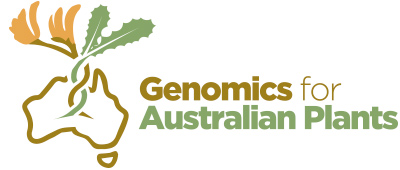Research
Publications, presentations and new research activities utilising data from the Genomics for Australian Plants Initiative will be added here.
GAP Publications and accession numbers
Acacia pycnantha (golden wattle) reference genome project
Syme, A., McLay, T., Udovicic, F., Cantrill, D. and Murphy, D., 2021. Long-read assemblies reveal structural diversity in genomes of organelles – an example with Acacia pycnantha. Gigabyte, 2021, pp.1-23.
https://doi.org/10.46471/gigabyte.36
McLay, T. G. B., Murphy, D. J., Holmes, G. D., Mathews, S., Brown, G. K., Cantrill, D. J., Udovicic, F., Allnutt, T. R., and Jackson, C. J. (2022). A genome resource for Acacia, Australia’s largest plant genus. PLOS ONE, 17(10), e0274267.
https://doi.org/10.1371/journal.pone.0274267
Accession numbers:
The Acacia genome project data (chloroplast and nuclear genome are the same archived reads):
Bioproject: PRJNA752212
BioSamples: SAMN20587791
Telopea speciosissima (waratah) reference genome project
Chen, S., Rossetto, M., Merwe, M., Lu‐Irving, P., Yap, J., Sauquet, H., Bourke, G., Amos, T., Bragg, J. and Edwards, R., 2022. Chromosome‐level de novo genome assembly of Telopea speciosissima (New South Wales waratah) using long‐reads, linked‐reads and Hi‐C. Molecular Ecology Resources,.
https://doi.org/10.1111/1755-0998.13574
Accession numbers: The Tspe_v1 genome was deposited to NCBI under BioProject PRJNA712988 and BioSample along with the raw data (ONT, 10x and Hi-C) to SRA as SRR14018636, SRR14018635 and SRR14018634.
Jones, A., Torkel, C., Stanley, D., Nasim, J., Borevitz, J., and Schwessinger, B. 2021. High-molecular weight DNA extraction, clean-up and size selection for long-read sequencing. PLOS ONE, 16(7), e0253830.
https://doi.org/10.1371/journal.pone.0253830
Ferguson, S., McLay, T., Andrew, R. L., Bruhl, J. J., Schwessinger, B., Borevitz, J., & Jones, A. (2022). Species-specific basecallers improve actual accuracy of nanopore sequencing in plants. Plant Methods, 18(1).
https://doi.org/10.1186/s13007-022-00971-2
Jackson C, McLay T, Schmidt-Lebuhn AN, in press. hybpiper-nf and paragone-nf: Containerization and additional option for target capture assembly and paralog resolution. Applications in Plant Sciences
[Note: Publication accepted, will be available online in April 2023]
Publications – Using GAP data
Schmidt-Lebuhn, A. N. (2022). Sequence capture data support the taxonomy of. Australian Systematic Botany, 35(4), 317–325.
https://doi.org/10.1071/sb22010
Schmidt-Lebuhn, A. N., Egli, D., Grealy, A., Nicholls, J. A., Zwick, A., Dymock, J. J., & Gooden, B. (2022). Genetic data confirm the presence of Senecio madagascariensis in New Zealand. New Zealand Journal of Botany, 1–13.
https://doi.org/10.1080/0028825x.2022.2148544
Barrett, R.L., Clugston, J.A.R., Cook, L.G., Crisp, M.D., Jobson, P.C., Lepschi, B.J., Renner, M.A.M. and Weston, P.H. (2021). Understanding Diversity and Systematics in Australian Fabaceae Tribe Mirbelieae. Diversity, 13(8), p.391. https://doi.org/10.3390/d13080391
Weston, P.H. (2022) Proteaceae. Flora of North America North of Mexico 10-11 (Oxford University Press: New York and Oxford).
Renner, M. A. M., Barrett, R. L., Clarke, S., Clugston, J. A. R., Wilson, T. C., & Weston, P. H. (2022). Morphological and molecular evidence refute a broad circumscription for. Australian Systematic Botany, 35(3), 127–179.
https://doi.org/10.1071/sb21030
Wilson, T. C., Rossetto, M., Bain, D., Yap, J. S., Wilson, P. D., Stimpson, M. L., Weston, P. H., & Croft, L. (2022). A turn in species conservation for hairpin banksias: demonstration of oversplitting leads to better management of diversity. American Journal of Botany, 109(10), 1652–1671.
https://doi.org/10.1002/ajb2.16074
Simões, A. R. G., Eserman, L. A., Zuntini, A. R., Chatrou, L. W., Utteridge, T. M. A., Maurin, O., Rokni, S., Roy, S., Forest, F., Baker, W. J., & Stefanović, S. 2022. A Bird’s Eye View of the Systematics of Convolvulaceae: Novel Insights From Nuclear Genomic Data. Frontiers in Plant Science, 13.
https://doi.org/10.3389/fpls.2022.889988
Joyce E, Appelhans M, Buerki S, Cheek M, De Vos J, Pirani J, Zuntini A, Bachelier J, Bayly M, Callmander M, Devecchi M, Pell S, Groppo M, Lowry II P, Mitchell J, Siniscalchi C, Munzinger J, Orel H, Pannell C, Nauheimer L, Sauquet H, Weeks A, Muellner-Riehl A, Leitch I, Maurin O, Forest F, Nargar K, Thiele K, Baker W, Crayn D (2023) Phylogenomic analyses of Sapindales support new family relationships, rapid Mid-Cretaceous hothouse diversification, and heterogeneous histories of gene duplication. Frontiers in Plant Science 14,.
https://www.frontiersin.org/articles/10.3389/fpls.2023.1063174
[Note: Publication accepted]
